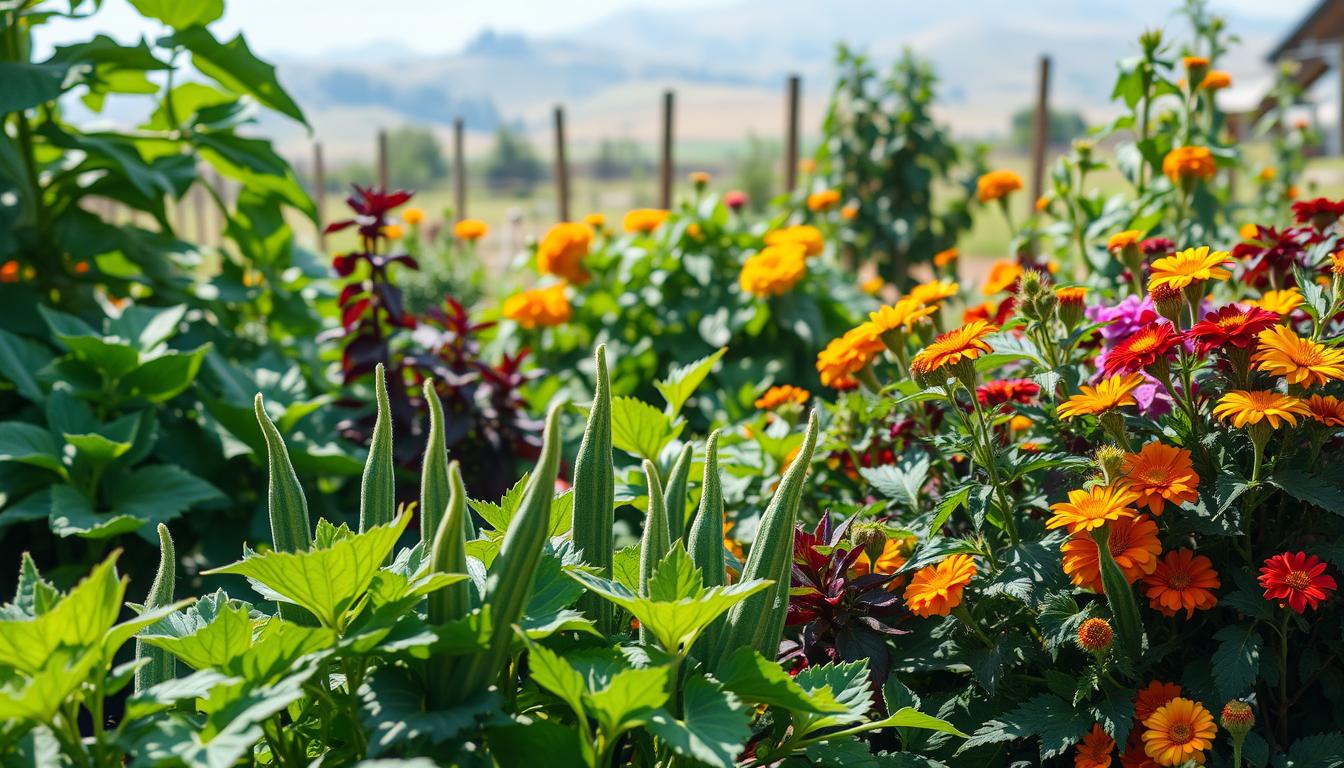Imagine stepping into your garden and being greeted by the vibrant greens and lively colors of flourishing plants. There’s something magical about nurturing a garden that not only feeds your body but also nourishes your spirit. As you cultivate your okra—one of the most rewarding vegetables to grow—you may find yourself wondering how to create that perfect balance within your garden ecosystem. Finding the best plants to grow with okra can transform your gardening experience into a true symphony of growth, flavor, and community, breathing new life into your outdoor space. In this okra companion planting guide, we’ll explore the wonderful world of companion planting, revealing how the right partners can elevate your okra and lead to a thriving garden.
Key Takeaways
- Understanding the interdependence of okra and its companion plants is crucial for a thriving garden.
- Companion planting can enhance growth, improve pest control, and promote better soil health.
- Explore how varied plants can complement each other to maximize yield and flavor.
- Learn about specific herbs, vegetables, and flowers that thrive alongside okra.
- Recognize which plants to avoid to prevent competition and harmful pests.
- Utilize planting strategies to create a harmonious and efficient garden layout.
Understanding Okra’s Needs
To cultivate a thriving okra garden, you must understand the specific requirements of the plant. Whether you are selecting okra garden companions or pairing your okra plant partners, acknowledging these needs will lead to optimal growth and yield.
Sunlight Requirements for Okra
Okra flourishes in full sunlight, requiring at least 6 to 8 hours of direct sun each day. Planting should occur after the last frost, ensuring soil temperatures reach or exceed 70°F for successful germination. A sunny location is essential for promoting strong stalks and abundant fruit.
Watering Tips for Healthy Growth
Consistency in watering is critical for your okra plants. Aim for about one inch of water per week, especially during periods of dry weather. This regular moisture not only supports healthy growth but also helps develop strong root systems, which are essential for thriving okra garden companions.
Soil Conditions for Optimal Yield
The soil quality can significantly impact your okra plants’ success. Ideally, well-drained, loamy soil with a pH range of 6.0 to 7.0 encourages deep root growth and prevents issues such as root rot. Amending the soil with organic matter can also enhance its structure and fertility, creating an ideal environment for okra plant partners.

Benefits of Companion Planting
Companion planting offers a multitude of advantages, particularly for your okra garden. By strategically combining plants, you can create an environment that supports natural pest control, enhances nutrient availability, and improves overall soil health. When you choose appropriate okra garden buddies, you set the stage for a flourishing garden.
Pest Control through Companion Planting
One of the key benefits of companion planting okra lies in its ability to manage pests naturally. Certain companion plants can repel harmful insects that threaten your crops. For instance, marigolds are known for their pest-repelling properties, helping to protect your okra from unwanted infestations.
Enhancing Nutrient Availability
Another advantage is the enhancement of nutrient availability in your garden. Companion planting encourages mutualistic relationships between plants, effectively boosting nutrient uptake. For example, legumes like beans can fix nitrogen in the soil, providing vital nutrients that benefit neighboring okra plants.
Improving Soil Health
Soil health is crucial for successful gardening, and companion planting can significantly improve it. When you incorporate diverse plants, you can increase soil structure and microbial activity, leading to richer, more fertile ground. This natural method supports long-term sustainability while allowing your okra garden to thrive.
| Benefit | Description |
|---|---|
| Pest Control | Repels harmful insects using strategic plant combinations. |
| Nutrient Availability | Enhances nutrient uptake through mutual relationships. |
| Soil Health | Improves soil structure and microbial activity. |
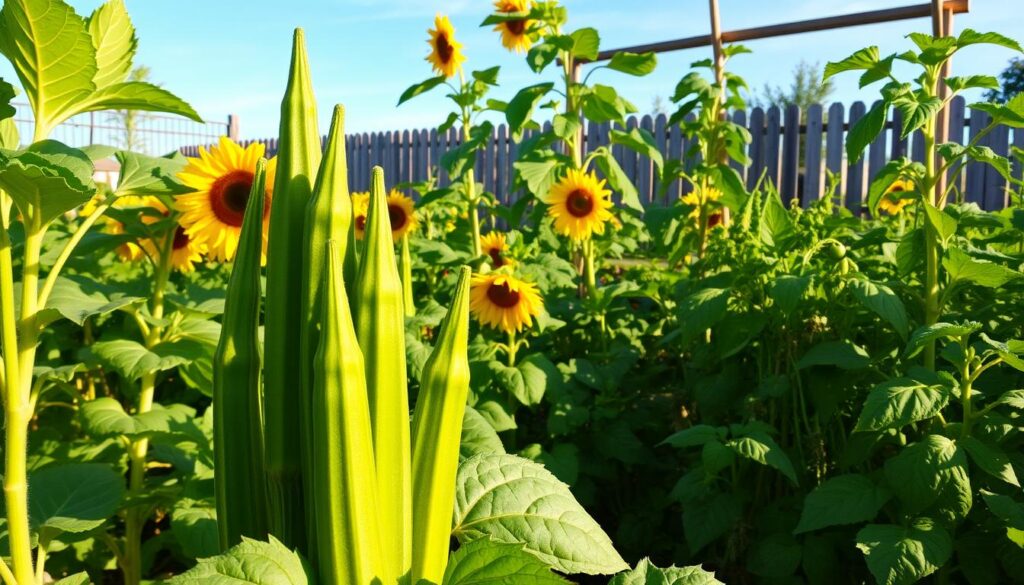
Best Companion Plants for Okra
Finding the right companions for okra is key to achieving a flourishing garden. Companion planting encourages a healthy garden ecosystem by enhancing growth, repelling pests, and maximizing the use of space. Here are some of the best okra companion plants that will work harmoniously with your okra crop.
Basil: A Flavorful Herb Partner
Basil thrives in full sun, making it an ideal partner for okra. This herb not only elevates the flavor of your dishes but also helps to repel pests like flea beetles and spider mites. By attracting beneficial pollinators, basil contributes to greater productivity, aligning perfectly with the principles outlined in your okra companion planting guide.
Marigold: Nature’s Pest Repellent
Marigolds bring vibrant hues to your garden while serving a vital role in pest management. These flowers are known to deter nematodes and other harmful insects. By incorporating marigolds among your okra plants, you can create a natural barrier against pests, ensuring their health and stability, enhancing your efforts to grow the best okra companion plants.
Cucumber: A Versatile Companion
Cucumbers share similar watering and nutrient needs with okra. When planted together, they help maintain soil moisture, fostering an ideal environment for growth. The lush foliage of cucumbers can also suppress weed growth, making cooperative gardening easier. This match-up is an excellent example of how strategic planning can yield a productive garden, as detailed in your okra companion planting guide.
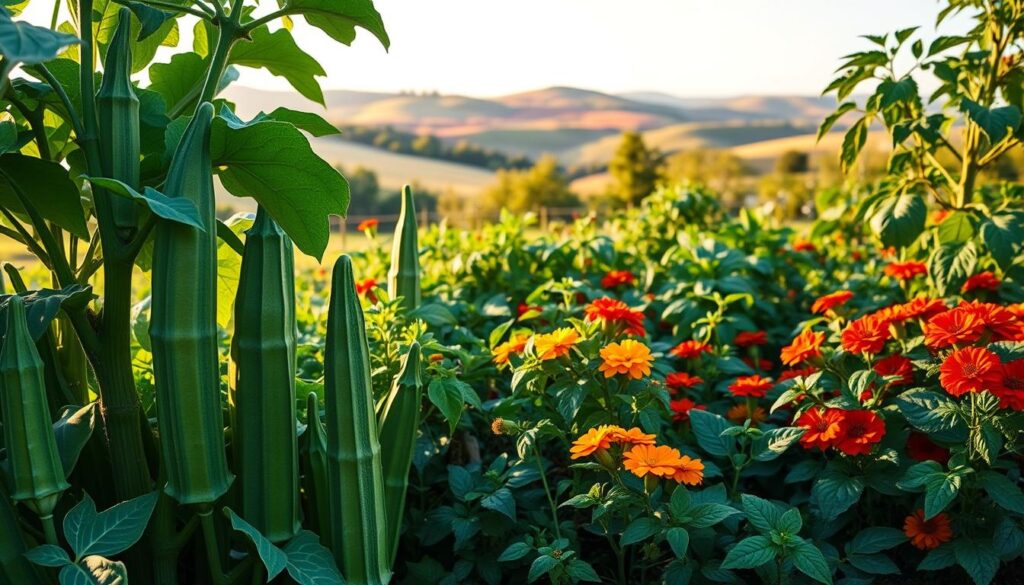
Herbs That Thrive with Okra
Integrating herbs into your okra garden can enhance productivity and flavor while attracting beneficial insects. These okra companion plants not only support okra’s growth but also add variety to your garden’s ecosystem. Below are some excellent choices for okra garden companions.
Dill: Attracting Beneficial Insects
Dill serves as a magnet for beneficial insects like ladybugs and lacewings, making it a valuable addition to your garden. This herb can enhance the biodiversity around your okra plants. The tall fronds of dill create a cool microclimate, benefiting the surrounding plants and improving overall garden aesthetics.
Cilantro: Enhancing Flavor and Growth
Cilantro is another splendid okra companion plant. It thrives well alongside okra, enriching the soil and providing a delightful flavor for your culinary needs. Its rapid growth enables you to harvest it early, leaving plenty of space for the okra to flourish without competition.
Mint: A Refreshing Companion
Mint grows vigorously without interfering with okra’s nutrient requirements. This herb not only adds a refreshing touch to dishes but can also deter certain pests that might affect your okra plants. The aromatic leaves of mint release essential oils that further enhance the garden’s natural defenses.
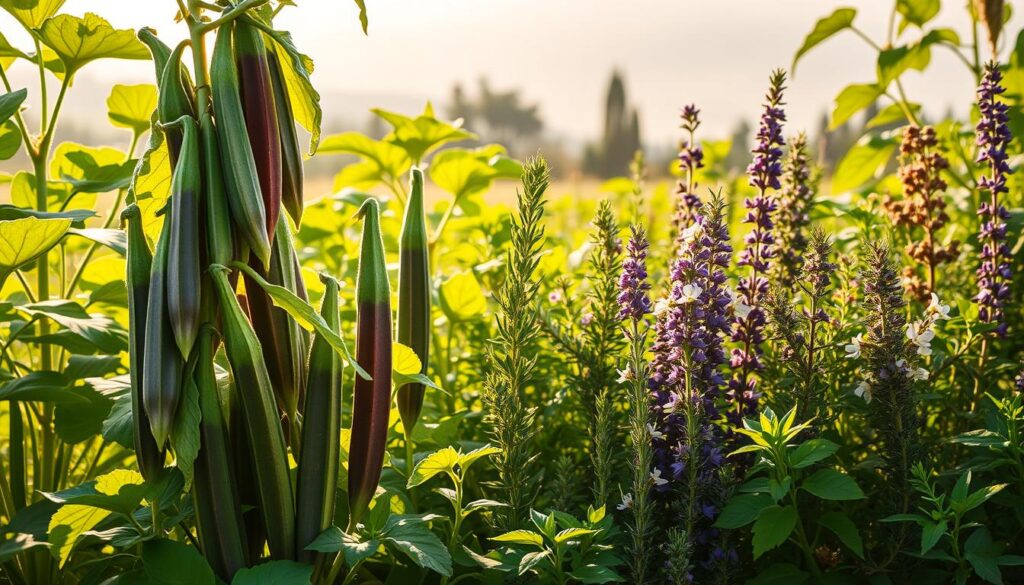
Vegetables That Pair Well with Okra
When planning your garden, choosing the right vegetables to accompany okra can enhance growth and resilience. Selecting compatible crops not only maximizes space but also encourages a thriving ecosystem. Below are some excellent options for okra and companion vegetables that can help your garden flourish.
Peppers: Complementing Growth Needs
Peppers thrive alongside okra, sharing similar soil and sunlight requirements. Their capacity to repel harmful pests, such as cabbage worms, provides an added layer of protection for your okra. This synergy allows both plants to flourish while minimizing potential threats, making them ideal companions in your garden.
Tomatoes: Mutual Benefits in the Garden
Tomatoes can create a mutually beneficial relationship with okra. Both vegetables enjoy similar growing conditions, yet strategic placement is essential to ensure they do not attract the same pests. When positioned correctly, tomatoes enhance the overall yield and health of okra while providing essential nutrients to the soil.
Eggplants: A Happy Harmonious Trio
Eggplants serve as another great companion for okra. They share sunlight and moisture preferences, ensuring compatibility in your garden layout. Eggplants contribute potassium to the soil, benefiting the growth of okra and enhancing the overall health of plants in close proximity. The pairing of these three vegetables results in a vibrant and productive garden.
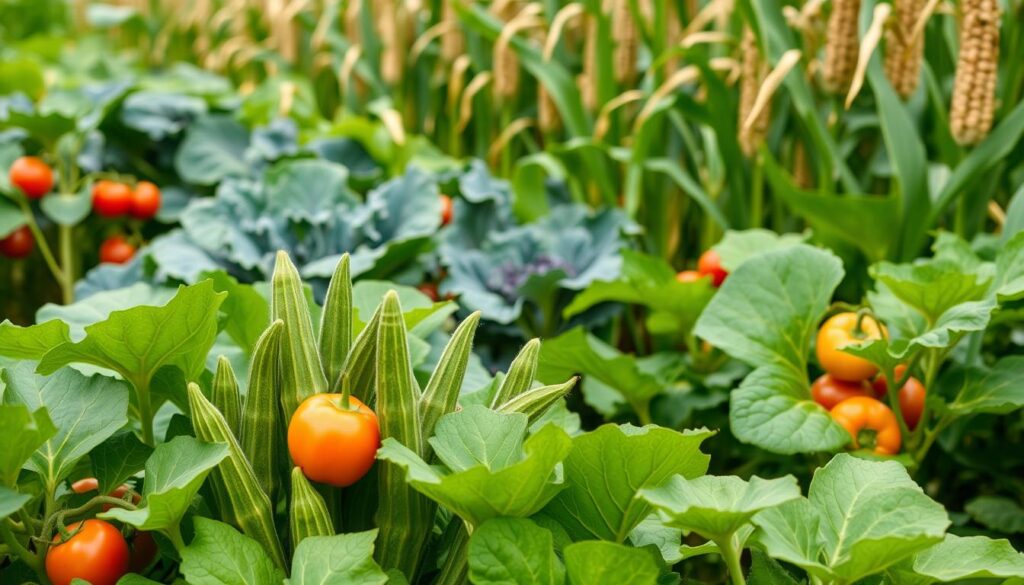
Flowers That Help Okra Flourish
Incorporating flowers into your garden can immensely benefit okra plants. The best plants to grow with okra not only provide visual appeal but also enhance pollination and deter pests. Here are a few flowers that work harmoniously with okra.
Sunflowers: Attracting Pollinators
Sunflowers are a wonderful addition to your okra garden. They attract bees and other beneficial pollinators, which leads to improved pollination for your okra plants. With better pollination, you can expect a more abundant harvest. Their tall stature also provides a natural shade, helping to regulate temperatures as well.
Nasturtiums: Natural Pest Deterrents
Nasturtiums serve as a true ally in your garden. These vibrant flowers act as trap crops, luring harmful pests away from your okra. They not only protect your plants but are also edible, adding extra value to your garden. Including nasturtiums enhances the overall balance of companion planting.
Zinnias: Adding Beauty and Benefits
Zinnias bring a splash of color to your garden while attracting various pollinators. Their cheerful appearance can brighten up any garden space. By attracting beneficial insects, zinnias contribute to the overall productivity of your okra plants, making them one of the best plants to grow with okra.

Companion Plants to Avoid with Okra
When planning your okra garden, it’s crucial to consider which plants may not coexist well with your okra companion plants. Several factors can lead to competition for nutrients and attract harmful pests, threatening the health and productivity of your okra garden buddies. Selecting the right pairings can make all the difference in your gardening success.
Avoiding Competitive Crops
Certain plants may compete aggressively with okra for resources such as water and nutrients. Crops like squash and sweet potatoes can undermine okra’s growth by depleting soil nutrients, creating a less favorable environment.
Toxic Plants: What to Watch For
Some plants may contain toxins that can harm okra. Be cautious when considering toxic plants for your garden, as they might disrupt the overall health of your precious okra garden buddies.
Plants That Attract Harmful Pests
It is critical to avoid plants that draw in harmful pests. For instance, certain varieties of tomatoes can attract nematodes, which pose a significant risk to the roots of okra. By steering clear of such plants, you can protect your okra from potential infestations.
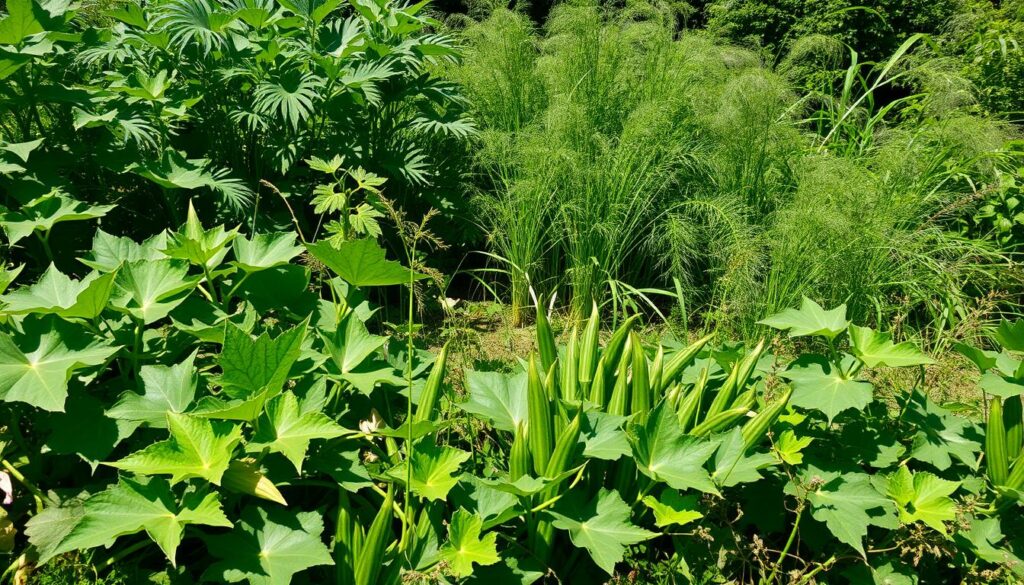
How to Arrange Companion Plantings
Arranging companion plantings can significantly impact the growth and health of your garden. When implementing companion planting okra, it is essential to consider several strategies that ensure optimal conditions for both your okra and its companions. This includes spacing plants appropriately to accommodate their unique needs and utilizing taller plants to create natural barriers.
Planting Strategies for Optimal Growth
Effective planting strategies promote the health of your okra. Consider the following practices:
- Plant okra in rows, allowing sufficient space for air circulation.
- Mix compatible plants, ensuring they don’t compete for sunlight.
- Group plants with similar water and nutrient needs to simplify care.
Creating a Natural Pest Barrier
Utilizing taller plants for pest management enhances the effectiveness of companion planting okra. For instance, sunflowers can shield lower crops like herbs and lettuce from pest infestations. This natural barrier helps maintain garden health without chemical pesticides.
Maximizing Garden Space Efficiently
Efficiency in garden space is crucial for a thriving ecosystem. Layering plants by height maximizes sunlight exposure and minimizes wasted space. Use vertical gardening techniques, such as trellises for climbing plants, to optimize your layout and incorporate more companion plants alongside your okra.
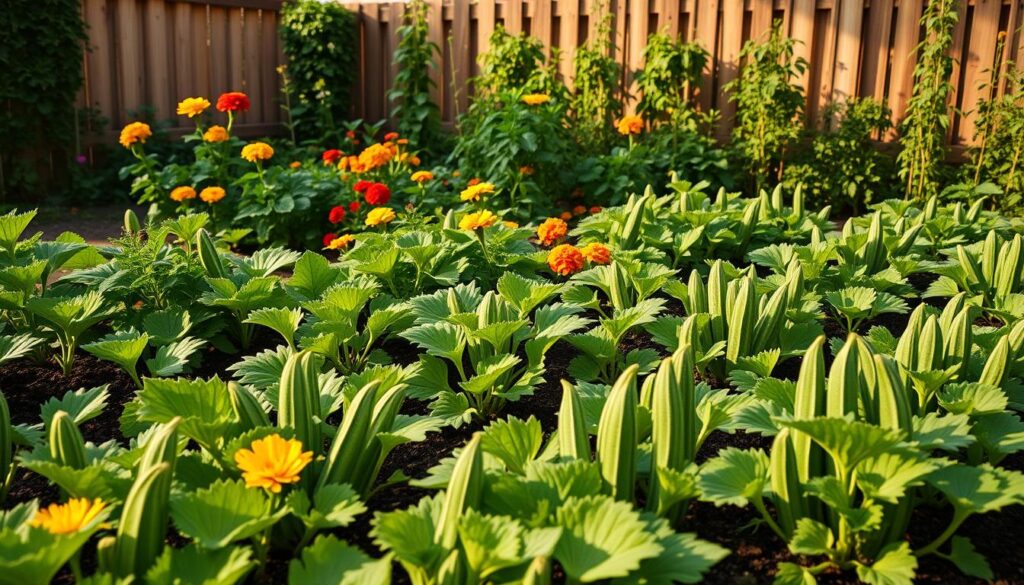
| Companion Plant | Benefit |
|---|---|
| Basil | Enhances flavor of okra and repels pests. |
| Sunflower | Creates height, attracting pollinators and reducing pest presence. |
| Marigold | Natural pest deterrent, protecting okra from harmful insects. |
Seasonal Considerations with Okra Companions
Understanding the seasonal dynamics of planting okra companion plants plays a critical role in maximizing your garden’s health and productivity. Each season offers unique opportunities for pairing plants effectively, ensuring a thriving garden environment.
Spring Planting: Perfect Pairs
In spring, there is a remarkable chance to sow seeds for fast-growing companions that benefit okra. Plants like radishes and peas serve as excellent options, promoting soil health while allowing space for okra to flourish as they mature. These initial plantings help establish a vibrant and diverse garden ecosystem.
Summer Planting: Keeping the Garden Thriving
As the summer sun intensifies, maintaining moisture levels in your garden is essential. Remove any invasive growth that competes for resources. During this period, nurturing your okra companion plants ensures they remain healthy, supporting each other in resisting pests and diseases. This collaborative environment allows for a stronger yield from your okra plants.
Fall Maintenance for Companion Plants
As the gardening season transitions to fall, careful maintenance is key. Focusing on the health of your companion plants prepares your garden for winter crops. Trim and care for existing plants to enhance their resilience. This proactive approach ensures a smooth transition into the colder months while promoting a rich soil base for the next growing season.
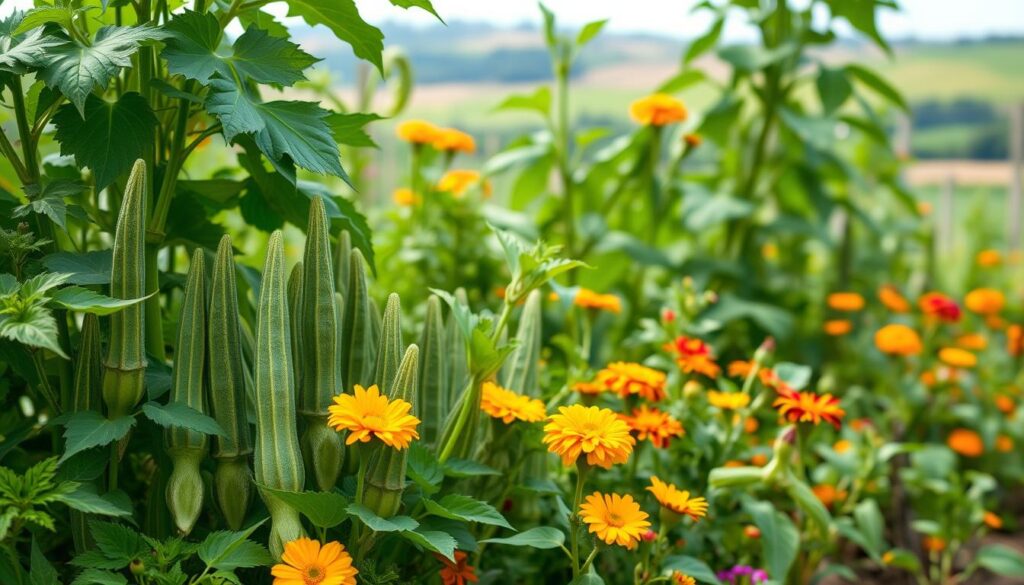
| Season | Actions for Okra Companion Plants | Benefits |
|---|---|---|
| Spring | Sow radishes and peas | Improves soil health and provides shade |
| Summer | Maintain moisture, remove invasive growth | Promotes strong growth and reduces pest issues |
| Fall | Care for existing plants, trim for winter | Prepares garden for winter, enhances soil quality |
Common Pests and How Companions Help
Pest management in your garden is crucial, especially when growing okra. Regular monitoring helps you identify common attackers like aphids and cabbage worms. Taking proactive measures with the right okra garden companions can prevent these pests from establishing a stronghold in your veggie patch.
Identifying Common Pests of Okra
Aphids, cabbage worms, and spider mites frequently target okra plants. Recognizing signs of these pests, like wilting leaves or visible webs, will allow you to act quickly. Early detection can minimize damage and ensure a healthy harvest.
Companion Plants That Deter Pests
Introducing specific okra garden companions to your gardening layout can pay off significantly in pest control. For example, planting basil near okra not only enhances flavor but also repels unwanted pests. Marigolds are another excellent choice, known for their ability to deter aphids and attract beneficial insects.
Encouraging Beneficial Insects
Incorporating flowers such as yarrow or dill around your okra plants will draw essential beneficial insects, including ladybugs and lacewings. These helpful creatures feed on common pests, providing natural pest control and reducing the need for chemical interventions in your garden.
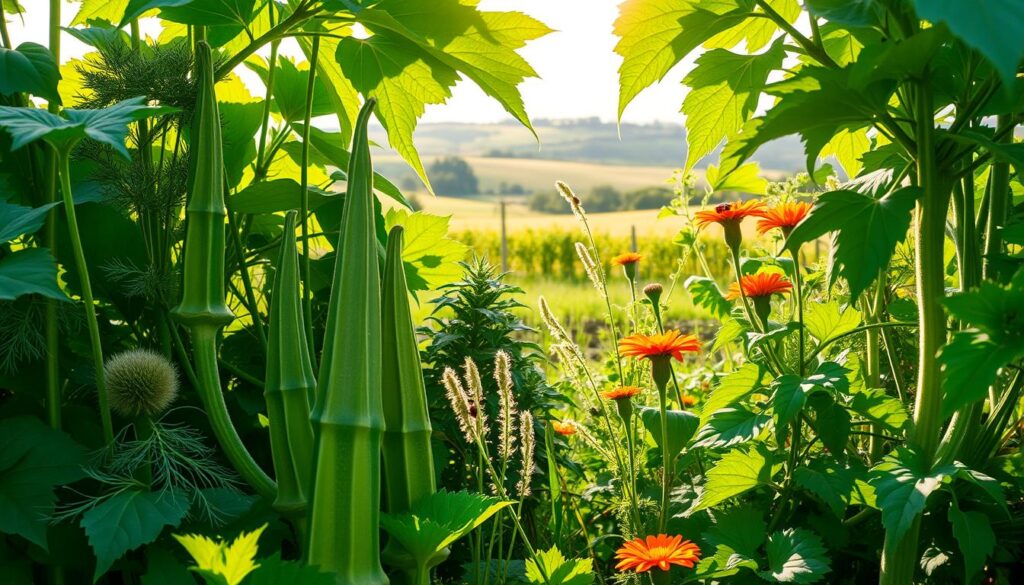
| Pest | Companion Plant | Benefit |
|---|---|---|
| Aphids | Basil | Deters aphids and enhances flavor |
| Cabbage Worms | Marigold | Repels cabbage worms and attracts beneficial insects |
| Spider Mites | Dill | Attracts natural predators |
Harvesting and Care for Okra and Companions
Harvesting okra at the right time enhances its flavor and contributes to a successful harvest. The best plants to grow with okra thrive in a well-maintained environment, so keep that in mind when planning your garden. Proper care after you collect your okra ensures that your companion plants continue to thrive, promoting a healthy ecosystem in your garden.
Timing Your Harvest for Peak Flavor
To achieve the best taste, aim to harvest okra when the pods reach about three inches in length. Regularly checking your plants will help you identify the perfect moment for harvesting. Quick collection helps maintain moisture and nutrients in the soil for your companion plants, supporting the dynamic of the best plants to grow with okra.
Maintaining Companion Plants After Harvest
After harvesting your okra, it’s essential to maintain the well-being of your companion plants. Continue to water generously and consider applying organic fertilizers to keep nutrient levels high. Companion plants will rely on these resources for ongoing growth, and a healthy mix of plants can enhance the garden’s overall yield.
Continuous Care for a Thriving Garden
Regular attention to your garden increases the chances of sustaining a vibrant ecosystem. Monitor the health of both okra and its companions diligently. Address any signs of pests or diseases promptly. By ensuring a supportive environment, you’ll benefit from the best plants to grow with okra and enjoy a bountiful harvest throughout the season.
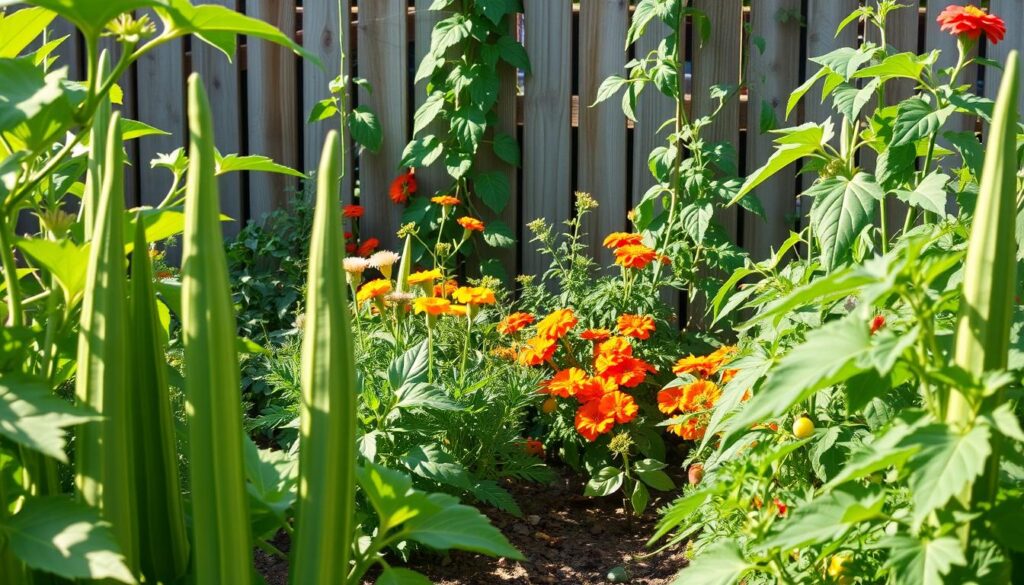
Building an Ecosystem with Companion Plants
Creating a vibrant garden ecosystem relies on the interconnected relationships between various plants. Implementing an okra companion planting guide facilitates healthier growth by encouraging beneficial interactions. This guide will help you understand how to manage pests naturally, enhance pollination for all your plants, and promote biodiversity in your garden.
Natural Pest Management Techniques
Growing companion plants alongside okra significantly aids in pest management. For instance, interspersing marigolds helps deter aphids and nematodes, while herbs like basil can repel harmful insects. By utilizing these natural pest control methods, you may reduce the need for chemical interventions, fostering a healthier garden environment.
Enhancing Pollination for All Plants
The right companion plants can contribute to improved pollination across your garden. Flowers such as sunflowers and zinnias attract pollinators like bees and butterflies. These essential creatures not only help in the pollination of okra but also enhance the yield of neighboring crops. Adopting strategies from an okra companion planting guide encourages a flourishing ecosystem.
Promoting Biodiversity in Your Garden
Encouraging biodiversity involves planting a variety of species and understanding their roles within the garden. Integrating different plants helps improve soil health and resilience against pests and diseases. When you embrace an okra companion planting guide, you cultivate an environment that supports varied life forms, benefiting both the plants and the local ecosystem.

By following these principles, you can successfully build an ecosystem that promotes harmony, reduces pests, and enhances overall plant health. This approach not only nurtures okra but enriches the entire garden experience for all your plants.
Tips for Successful Companion Gardening
Engaging in companion gardening can elevate your success with okra companion plants. Starting with a few carefully selected plants allows you to observe their interactions and growth patterns. This approach provides a solid foundation for expanding your garden in future seasons.
Starting Small: Choosing Key Companions
Begin by selecting a few okra companion plants that have proven benefits. Plants such as basil and marigold enhance your garden’s productivity while deterring pests. Focus on combinations that thrive together, enabling you to monitor their progress without overwhelming yourself.
Observing Growth Patterns for Improvement
Keep a record of how each plant performs alongside your okra. Pay attention to growth rates and any signs of pest activity. Identifying successful partnerships will help you refine your strategy for subsequent planting seasons, ensuring optimum results as your gardening skills evolve.
Sharing Knowledge and Experiences
Connecting with other gardeners can provide valuable insights. Share observations and outcomes regarding different okra companion plants. This reciprocal exchange of knowledge fosters community learning and may introduce you to new, effective planting combinations you might not have considered.
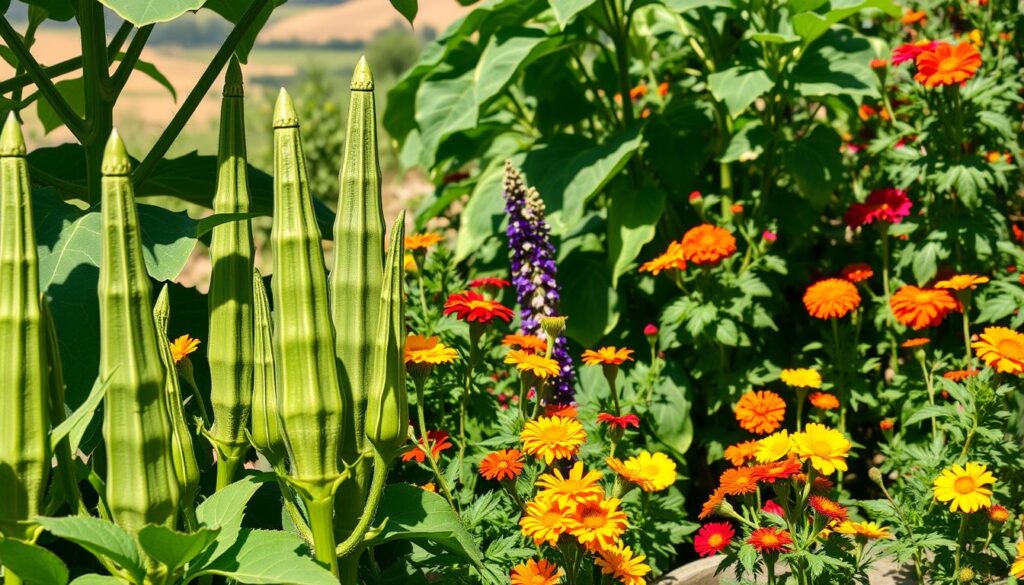
Conclusion: Growing Together for a Thriving Garden
As you wrap up your journey in understanding the vital role of okra garden companions, it’s clear that companion planting is not just a trend, but a sustainable practice that encourages bountiful growth. Each partner plant plays a significant role, creating a symbiotic environment where okra can flourish. By choosing the right companions, you can boost yields and enhance the overall health of your garden.
Encouraging a healthy garden ecosystem starts with understanding the delicate relationships between your plants. When you plant okra alongside supportive companions, you help to create a balanced environment that fosters growth, deters pests, and attracts beneficial insects. This interconnectedness is the key to maintaining a thriving garden for seasons to come.
Looking ahead, you’re empowered to embark on future gardening adventures. Keep experimenting with different okra garden companions, monitor their interactions, and adapt your methods to optimize the growing conditions. With each planting season, you’ll uncover new possibilities and enrich your gardening experience, making every garden space a delightful retreat.
